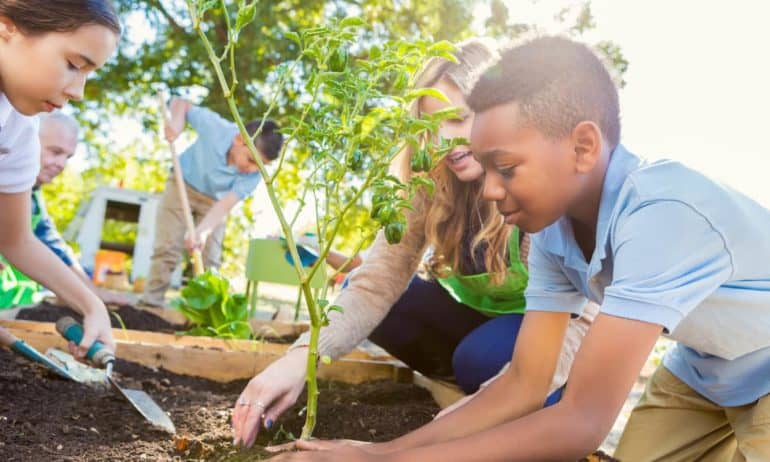Contributing Authors: Katherine Walla and Hayly Hoch
This holiday season, we’re highlighting 12 children’s books that will educate and inspire future eaters, food producers, and innovators. From stories exploring community gardens and ugly vegetables, to tales about feeding a hungry stranger and slaying “the climate dragon,” these books discuss deep topics in a personalized and fun way. Happy holidays!
1. Amelia’s Road by Linda Jacobs Altman, illustrated by Enrique O. Sanchez
Amelia’s Road follows Amelia Luisa Martinez, a young girl who lives in a family that travels around the country as migrant farmworkers. Although her day-to-day is characterized by long work days, unfamiliar schools, and bleak cabins, she one day finds an old tree that becomes a special place for her. Amelia’s Road offers children a chance to reflect on the experiences of migrant farmworker families.
2. Apple Farmer Annie by Monica Wellington
This book tells the story of Annie, a young apple farmer. As she picks, sorts, and sells her apples, she enlists the help of readers with some small, challenging activities such as counting, object-naming, and money counting. Author Monica Wellington includes her personal recipes for applesauce, applesauce cake, and apple muffins.
3. Community Soup by Alma Fullerton
Author Alma Fullerton tells the story of a young Kenyan girl, Kioni: her herd of goats followed her to school and began destroying the school’s garden. Kioni and her friends join together to find a creative solution, making a tasty vegetable soup and saving Kioni’s goats. Community Soup offers readers an uplifting story about the power of communal projects.
4. Green Green: A Community Gardening Story by Marie Lamba and Baldev Lamba, illustrated by Sonia Sanchez
Through charming rhymes, this book tells the story of a city’s dwindling green space—and the neighborhood children who inspire the community to recover it. Authors Marie Lamba and Baldev Lamba playfully highlight the power of collaboration among people of any age who want to improve their communities.
5. Little Seeds by Charles Ghigna, illustrated by AG Jatkowska
As one of a four-part My Little Planet series, Little Seeds follows three children that celebrate spring by planting a seed. Readers find that while it is fun to garden, it is also fun to take care of the planet by doing activities like planting seeds.
6. Our Community Garden by Barbara Pollak
In Our Community Garden, Audrey Aubergine and her friends describe their favorite activities at their community garden. Together, the children get excited about everything from getting their hands dirty to exploring the bugs on their plants. The story offers children of all ages an opportunity to learn about the possibilities that can result from people who join to work—and have fun—together.
7. Plants Feed Me By Lizzy Rockwell
This book celebrates the plants that grow all around us: the trees, roots, bushes, and stems that nourish our communities. Author Lizzy Rockwell takes readers to the farm, orchard, and community garden to discover the various parts of plants humans eat, revealing food’s beauty.
8. Stone Soup, a classic tale
Originally a French tale from the early 18th century, Stone Soup tells the story of a hungry man who approaches the house of a woman seeking food. While the woman turns him away for begging, the man tricks her into cooking by showing her a stone that makes soup with simply fire and a pot of water. The man tricks the woman by asking her to add vegetables and herbs throughout the process, ending with a fantastic soup for everyone to enjoy.
9. That’s Not Fair! / ¡No Es Justo! by Carmen Tafolla and Sharyll Teneyuca, illustrated by Terry Ybáñez
Authors Carmen Tafolla and Sharyll Teneyuca tell the true story of Emma Tenayuca, a young Mexican-American girl in San Antonio in the 1920s. After watching her community work unreasonably long hours for low wages and struggle with hunger, Emma begins to advocate for Mexican-American workers, eventually leading 12,000 in a struggle for justice. The story offers parents a starting point to talk about each individual’s role in making a more just food system.
10. The Curious Garden by Peter Brown
Authored and illustrated by Peter Brown, this book celebrates a discovery of a love for gardening. The main character, Liam, discovers a struggling garden, brings it back to life, and finds his efforts have a city-wide impact. The story opens the door for a conversation around the importance of green spaces in urban settings and the power of a single green thumb.
11. The Ugly Vegetables by Grace Lin
Author and illustrator Grace Lin tells the story of a young girl tending an ugly garden—one that lacks colorful flowers and stunning butterflies, yet produces the tastiest vegetables. Once the girl’s mother harvests the vegetables for a tasty Chinese soup, the young gardener learns that everything has value: including ugly vegetables. Lin tops off the story with her recipe for ugly vegetable soup.
12. What’s On Your Plate: Exploring the World of Food by Whitney Stewart, illustrated by Christiane Engel
This book, written by Whitney Stewart and illustrated by Christiane Engel, takes young readers around the globe, introducing them to new tastes and flavors in countries like Brazil, Ethiopia, Japan, Morocco, and more. Each section includes an easy recipe for children to cook with a parent for an interactive way to learn about the diversity of ingredients each country and the role of culture in cuisine.
Bonus: Slaying the Climate Dragon by Kate Marvel
Although not a book (yet), this short story authored by Kate Marvel is a wonderful resource for starting a conversation with young children on climate change. The story’s open ending allows space for youth to brainstorm the ways they can join the good fight to slay “the climate dragon.”













